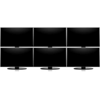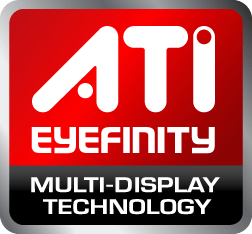- Qualcomm Launches Snapdragon 4 Gen 2 Mobile Platform
- AMD Launches Ryzen PRO 7000 Series Mobile & Desktop Platform
- Intel Launches Sleek Single-Slot Arc Pro A60 Workstation Graphics Card
- NVIDIA Announces Latest Ada Lovelace Additions: GeForce RTX 4060 Ti & RTX 4060
- Maxon Redshift With AMD Radeon GPU Rendering Support Now Available
The Benefits of Multi-Display Gaming

Think that gaming across three or more displays delivers little more than a larger game? Not true, as the wider the resolution, the more of the game you see. Not only can multi-display gaming increase the immersion level, but it can even give you a competitive advantage online. Yes, we have many examples to help prove our point.
Page 1 – Introduction
A couple of months ago, I received a rather monstrous shipment from AMD. It was so large, in fact, that the FedEX guy who delivered it asked me to give him a heads-up as to when I’d be sending it back, so that he could book that day off! Within all of those boxes were six Dell 22″ displays and the required mounts. It was time to get down to business with Eyefinity.
To say that we gave the technology a good test with what we were sent would be a major understatement. At the time of our in-depth article on Eyefinity being posted, I calculated that we devoted at least 75 hours to actual gaming, and about 10 to trouble-shooting and experimentation. Prior to receiving the kit, I wasn’t even sure what thoughts I’d be left with, but afterward, I was sold.
In the conclusion of that article, one of the “Cons” I listed was, “Once you use Eyefinity, you learn to hate going without it.”, and that wasn’t only meant to be a witty line. It’s absolutely true. After the Eyefinity article was posted, I got down to testing out Sapphire’s Radeon HD 5870 Vapor-X 2GB, and I could feel a little distaste due to being “stuck” with 2560×1600 as the max resolution. Yes, in some ways, multi-display gaming can really scar you.
As thorough as our Eyefinity article was, however, there was one rather significant point that we failed to drive home. That is, the actual advantage that multi-monitor gaming can give you. In talking to many people over the past couple of months, and reading comments around the Web, many people say that they would rather have a large screen (50″+ TV or projector) than use Eyefinity, or multi-display setups in general. That’s a good argument, especially since that solution wouldn’t give you the bezel problem.

But comments like those forced me to get down to further testing with Eyefinity, because the biggest advantage to multi-display gaming that many people don’t realize is that while your game is going to be obviously physically larger, you also get far more game as well. In most cases, a 3×1 1080p setup will literally deliver to you 300% of the game world.
It shouldn’t be too difficult to understand the benefits of this. In single-player games, seeing much more of the game world simply increases the levels of immersion, while for online multi-player, using such a setup would give quite the competitive advantage. Don’t believe me? Just wait until you see some comparative screenshots, of which this article provides many.
A couple of months ago, [H]ard|OCP’s ever vocal Kyle Bennett posted an editorial where he recommended avoiding the game Global Agenda, an FPS-based MMO title. The reason? The developers deemed it unfair for players to use multiple displays, so it disabled the ability to run the game on more than one.
At that time, I didn’t think too much of it, or even understand what kind of advantage the company could have been talking about. After seeing similar differences for myself, though, I am sold on the fact that if you want the best possible advantage in an online game, multi-display is the way to go.
As you can likely tell by now, this is going to be more of a simple article, with no performance benchmarks or anything of the sort. Rather, we went through 17 different games at three different resolutions (1920×1080, 5760×1080 and 5760×2160), and using the exact same scenes, we show you the real differences in what you see in the game should you move to one of the bigger setups.
All of the screenshots in this article can be clicked to view their original resolution, but be warned as the full versions range from between 300KB up to 5.5MB.
Warning: After seeing these comparisons, you may be overcome with an insatiable desire to sink some cold hard cash on an Eyefinity setup.
On we go!
Support our efforts! With ad revenue at an all-time low for written websites, we're relying more than ever on reader support to help us continue putting so much effort into this type of content. You can support us by becoming a Patron, or by using our Amazon shopping affiliate links listed through our articles. Thanks for your support!





